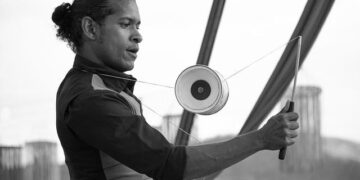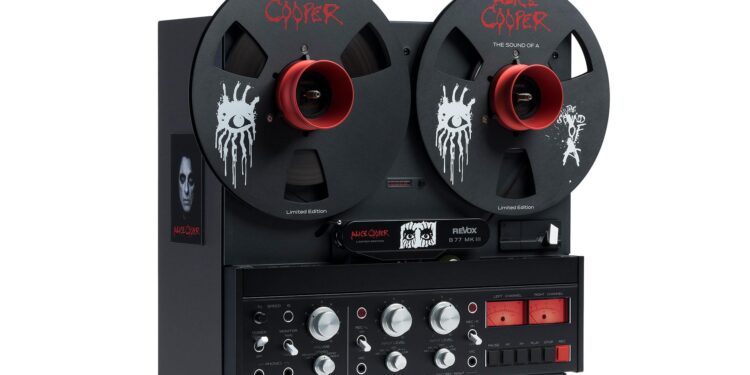A chance discovery of a forgotten tape recorder has paved the way for Tunde Adebimpe’s debut solo album, as detailed in a recent feature on NPR’s World Cafe. Known primarily as the frontman of the indie rock band TV on the Radio, Adebimpe’s unexpected archival find unlocked a treasure trove of raw recordings and creative ideas, ultimately shaping the sound and direction of his first solo project. This article explores how the rediscovery of these forgotten tapes not only influenced the album’s production but also offered a unique glimpse into the artist’s evolving musical journey.
Discovery of a Forgotten Tape Recorder Sparks Creative Revival for Tunde Adebimpe
In an unexpected twist of fate, Tunde Adebimpe stumbled upon an old tape recorder tucked away in a dusty corner of his studio, unveiling a treasure trove of melodies and riffs he’d recorded years ago. These forgotten snippets became the blueprint for his debut solo album, breathing new life into ideas that had long been shelved. The analog warmth of the recordings not only inspired the sonic direction of the album but also reconnected Adebimpe with a more spontaneous and raw creative process, reminiscent of his earliest days as a musician.
The rediscovery sparked a wave of experimentation, blending past and present influences. Adebimpe described the experience as an “organic revival,” where the imperfections of tape added character and depth to his compositions. Key elements that defined this creative rebirth include:
- Rediscovery of Authenticity: Embracing the original demos’ imperfections.
- Hybrid Soundscape: Fusing analog textures with modern production.
- Emotional Resonance: Revisiting forgotten emotions captured on tape.
| Stage | Impact |
|---|---|
| Tape Discovery | Ignited creative inspiration |
| Listening Sessions | Unearthed raw, emotional content |
| Recording Phase | Blended old demos with new ideas |
| Album Release | Showcased unique fusion sound |
Unveiling the Raw Sounds and Personal Stories Behind the Debut Album
In a serendipitous twist of fate, an old tape recorder tucked away in a forgotten drawer became the catalyst for Tunde Adebimpe’s highly anticipated debut album. This analog relic captured candid moments and unfiltered soundscapes that would have otherwise slipped into obscurity. The rawness of these recordings infuses the album with an authenticity that digital precision often sanitizes, allowing listeners to experience the artist’s most intimate and unguarded emotions. The warmth of tape hiss and spontaneous outtakes provide a narrative not only of the music but of the journey behind it.
Beyond the sonic textures, the album is a tapestry woven with personal stories and reflections-each track a chapter that reveals different shades of Adebimpe’s identity, struggles, and aspirations. The following elements shaped the essence of the project:
- Improvised moments: Many songs bloomed from unexpected improvisations captured on the forgotten tape.
- Collaborative fragments: Contributions from close friends and fellow artists appear as spontaneous interludes.
- Emotional transparency: The vulnerability in early demo takes remains intact, offering a window into the creative process.
| Track | Origin of Recording | Notable Element |
|---|---|---|
| “Fragments” | Bedroom sessions, 2018 | Intimate vocal takes |
| “Echoes” | Park bench improvisation, 2019 | Ambient natural sounds |
| “Lost Tapes” | Garage studio demo, 2017 | Unpolished guitar riffs |
How Emerging Artists Can Harness Analog Memories to Fuel Modern Music Projects
In an age dominated by digital production and auto-tuned perfection, the rediscovery of analog equipment can spark a fresh wave of creativity for emerging artists. Tunde Adebimpe’s journey from unearthing a long-forgotten tape recorder to crafting his debut album is a testament to this. By embracing the tactile imperfections and warm resonance of analog recordings, artists gain access to sounds and textures that evoke authenticity and evoke emotional depth often lost in digital processes. This tactile engagement with music-making not only shapes the sonic character but also invites experimentation with spontaneous glitches, layering of sounds, and organic fades-elements that breathe life into new projects.
- Rediscovering past recordings: Digging through old tapes can reveal unfinished melodies and hidden vocal takes.
- Embracing imperfections: Analog hiss, warbles, and tape saturation add distinctive warmth.
- Hands-on creativity: Physical manipulation of tape spools inspires unique soundscapes.
- Resisting the digital polish: Prioritizing mood and texture over clinical clarity invites fresh artistic direction.
For emerging musicians aiming to harness this analog charm, it helps to balance nostalgia with innovation. Below is a comparison illustrating how analog elements can complement modern recording techniques to create a unique sonic identity:
| Aspect | Analog Approach | Modern Digital Approach | Hybrid Advantage |
|---|---|---|---|
| Timbre | Warm, textured, imperfect | Clean, precise, controlled | Rich, detailed, emotionally expressive |
| Workflow | Slow, deliberate, hands-on | Fast, flexible, non-destructive | Balanced pace fostering creativity |
| Production | Layering via physical edits | Infinite tracks and plugins | Organic complexity with polish |
In Summary
The rediscovery of that long-forgotten tape recorder not only sparked a creative journey for Tunde Adebimpe but also culminated in the release of his debut album, a testament to the enduring power of nostalgia and artistic exploration. As chronicled on World Cafe by NPR, this unexpected catalyst serves as a reminder that inspiration can emerge from the most unlikely of places, reshaping an artist’s path and enriching the music landscape in the process.































